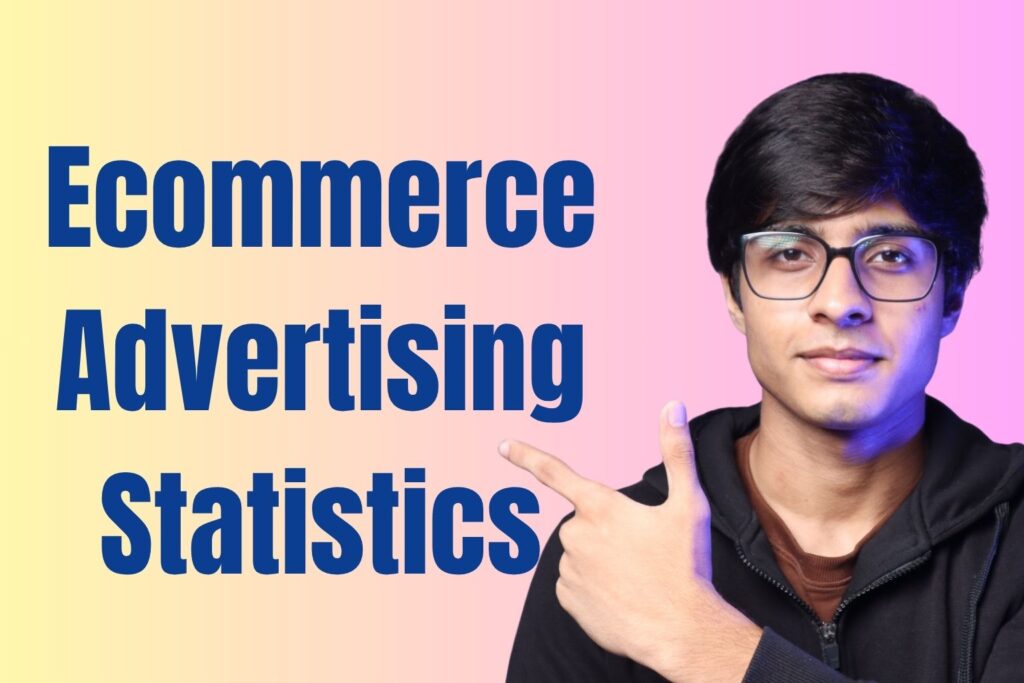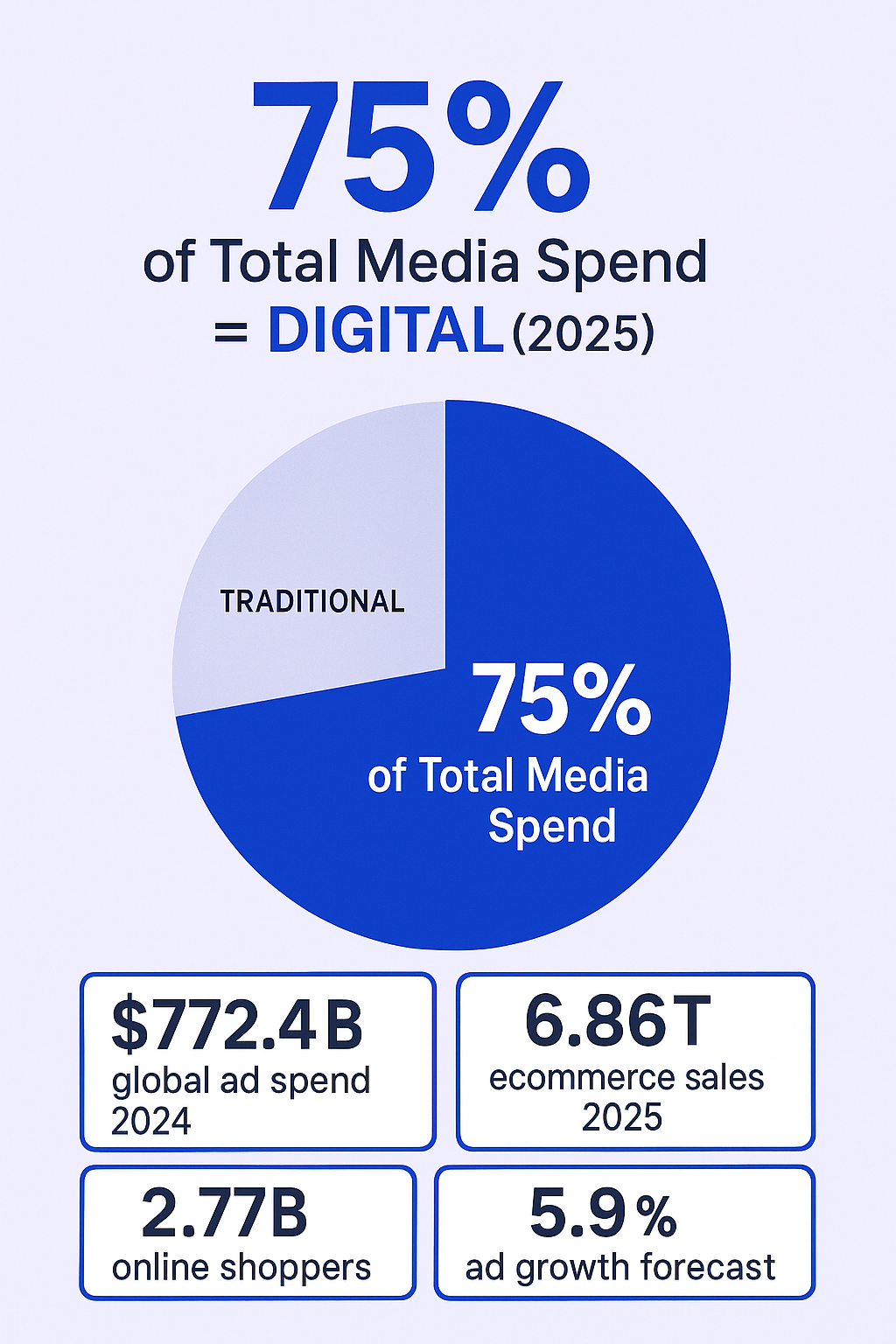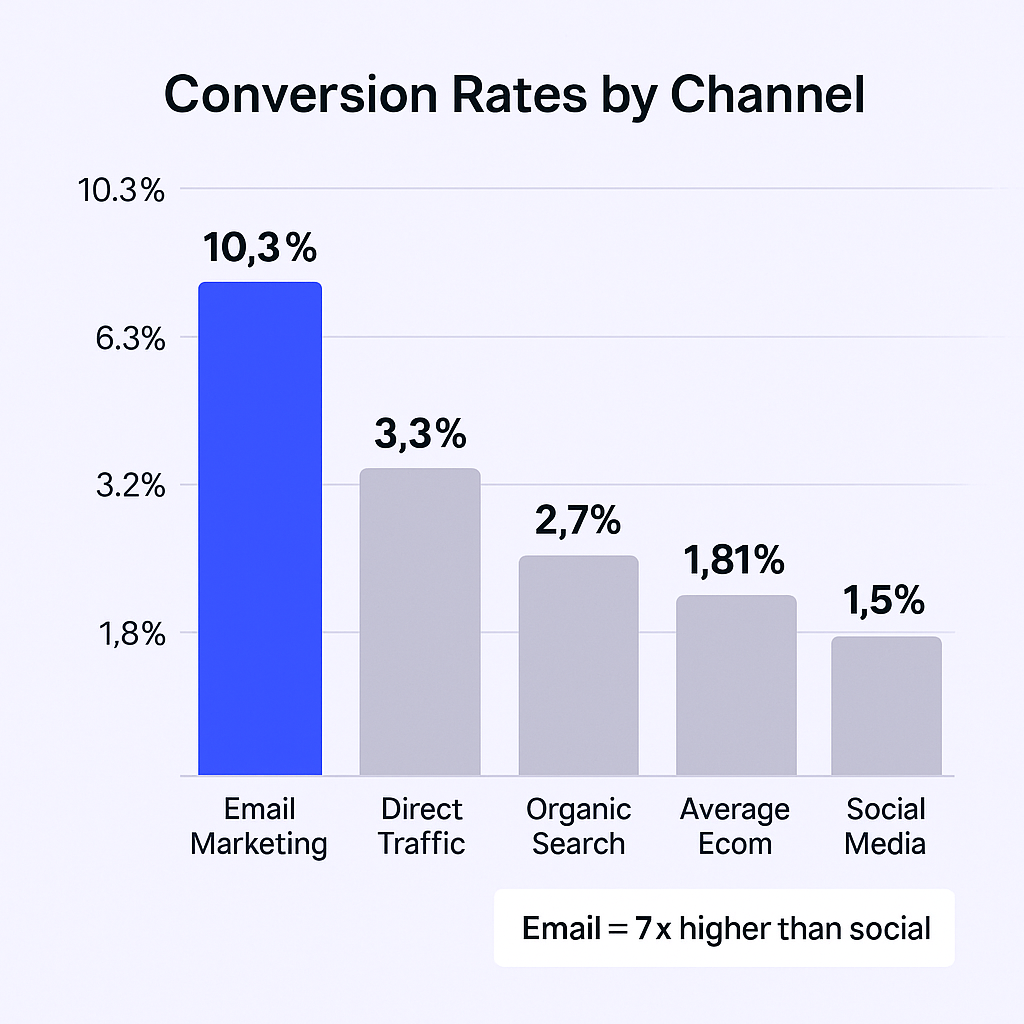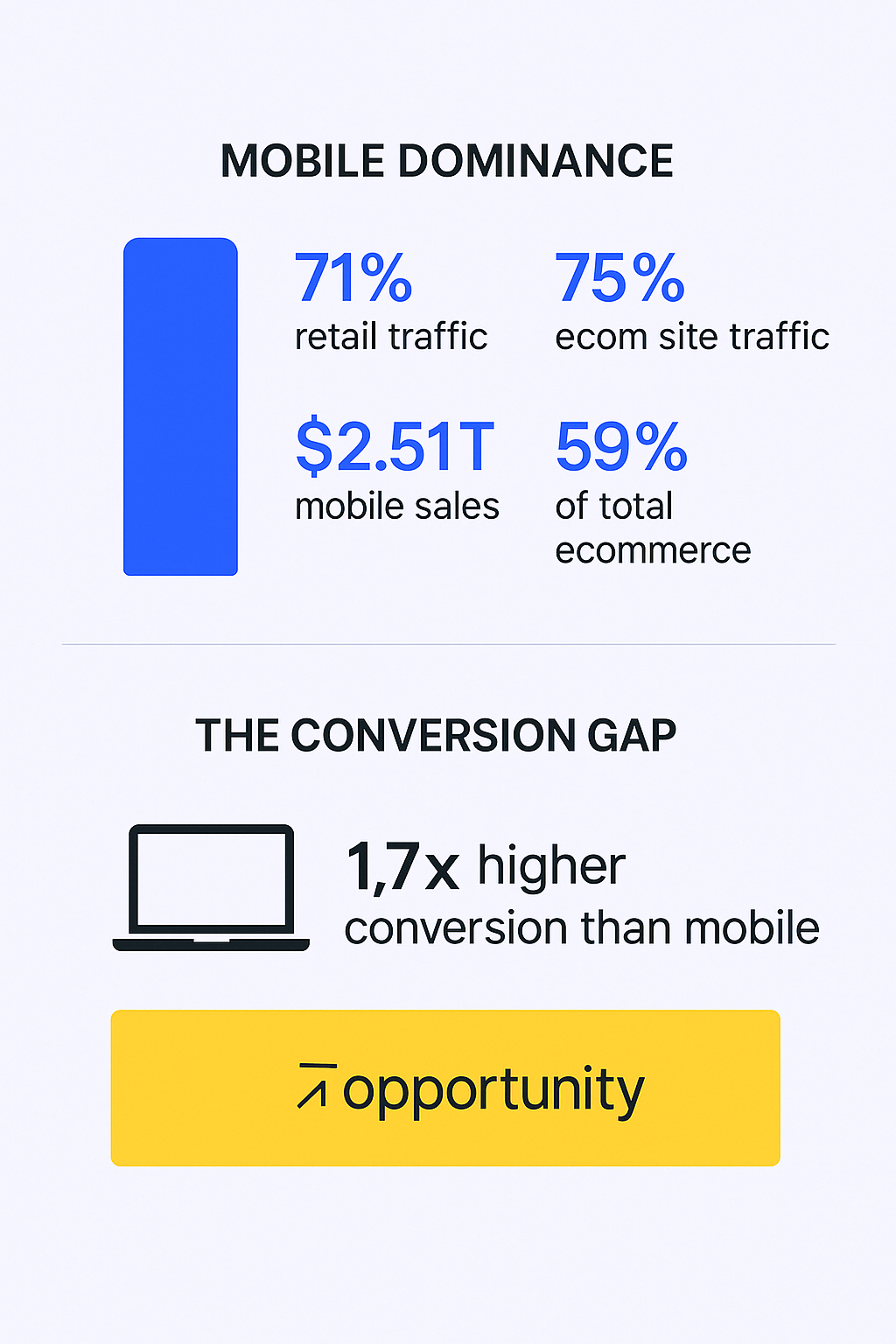- blog
- Statistics
- Ecommerce Advertising Statistics 2025: Key Trends & Insights

Ecommerce Advertising Statistics You Need to Know in 2025 (And What They Mean for Your Sales Game)
Table of Contents
Ecommerce Advertising Statistics
- Digital advertising dominance will account for 75% of worldwide total media ad spending for the first time in 2025, showing the shift away from traditional channels
- Global ecommerce sales will reach $6.86 trillion in 2025, representing an 8.37% increase from 2024 and creating massive advertising opportunities
- Mobile traffic accounts for 71% of retail traffic worldwide, with mobile ecommerce representing 44.1% of US online sales worth $564.1 billion
- Social media presence increases sales by 32% on average for online stores compared to those without social platforms
- Social media ad spending reached nearly $250 billion in 2024, with a 15% increase compared to 2023 showing continued platform investment
- Email marketing conversion rates average 10.3% thanks to segmentation and personalization, delivering $36-40 ROI for every dollar spent
- Average ecommerce conversion rate ranges between 2-4% globally, with top performers achieving 3.2% or higher placing them in the top 20% of all stores
- Multi-brand retail achieves the highest conversion rates at 4.97%, followed by consumer goods at 4.21% across industry benchmarks
- Direct traffic sources convert best at 3.3% average conversion rate, while social media converts lowest at 1.5% across all industries
- Digital video ad spend will reach $72.4 billion in 2025, up 14% from 2024 as video captures nearly 60% of all US TV/video ad spending
- Mobile commerce revenue reached $2.51 trillion in 2025, accounting for 59% of total ecommerce sales worldwide
- Desktop conversion rates are 1.7 times higher than smartphone conversion rates, despite mobile driving more traffic volume
- Online shoppers globally total 2.77 billion as of 2025, with 21% of all retail purchases expected to happen online
- Retail media growth leads at 21.9% year-over-year as advertisers capitalize on valuable retailer consumer data insights
- Gen Z product discovery shows 64% use social media to find new products, compared to 59% of Millennials and 47% of Gen X
Hey there, sales pros! Ever feel like you’re shooting in the dark when reaching out to ecommerce businesses? Understanding their world, especially how they’re spending big on ads, can be your secret weapon. These aren’t just numbers; they’re clues to your prospect’s challenges, goals, and where they’re investing. Knowing these ecommerce statistics can help you tailor your pitch, ask smarter questions, and ultimately, close more deals.
Simply put, ecommerce advertising is all about promoting online stores and products to drive sales through digital channels. Think about it: if a prospect is pouring money into social media ads but their industry typically sees low conversion from that channel, they might be hungry for solutions that improve lead quality or outreach effectiveness—perhaps like better email campaigns driven by high-quality contact data.
In this article, we’ll break down the key advertising statistics for ecommerce, making them easy to grasp and, more importantly, easy for you to use. Let’s dive in!
Digital Advertising: Key Highlights
To kick things off, let’s look at some headline figures that paint a picture of the ecommerce advertising landscape. These stats show just how dynamic and significant this space is:
- Digital ad spending will account for more than 75% of worldwide total media ad spending for the first time in 2025
- Mobile devices account for 71% of retail traffic worldwide and mobile ecommerce accounts for nearly half (44.1%) of US online sales in 2024, representing $564.1 billion in order value
- Online stores that also have a social media presence have, on average, 32% more sales than those not using social media
- Digital video is set to capture nearly 60% of all U.S. TV/video ad spend in 2025, a staggering leap from just 29% in 2020
- Email marketing has an average conversion rate of 10.3% thanks to its highly segmented and personalized nature. This explains its high ROI—36 to 40$ for every dollar spent
Impressed? These are just the headlines.

These big numbers indicate a thriving, competitive market. Businesses are spending significantly, which means they are under pressure to see results. This creates opportunities for solutions that enhance their advertising ROI or provide complementary lead generation. Let’s dig deeper into what these numbers mean for the ecommerce world and, more importantly, for you.
Digital Advertising Statistics — Ad Spend And Budgets
The digital ad market isn’t just growing; it’s exploding. Global advertising spend for 2024 reached $772.4 billion with Ad spend growth forecast to continue at 5.9% in 2025, making digital the dominant force in media spending.
Global eCommerce sales will account for $6.86 trillion in 2025, which is an 8.37% increase from 2024. Even more impressive, the global ecommerce market is expected to total $4.8 trillion in 2025 with about 23% of total retail sales happening online by 2027.
This massive ad spend is fueled by the sheer size of the ecommerce market itself. There are 2.77 billion global online shoppers as of 2025, and 21% of retail purchases are expected to take place online in 2025, rising to 22.6% by 2027.
Looking at specific investment areas, retail media is leading the way at +21.9% year-over-year growth as advertisers capitalize on the high value of retailer consumer data. Meanwhile, paid search is expected to increase by 6.7% driven by continuous advancements in AI-powered features.
What This Means for You (BDRs & AEs):

When you see these colossal spending figures, understand that your ecommerce prospects are under immense pressure to get a return on that investment. High ad spend without corresponding sales growth is a major pain point. This pressure cooker environment means businesses are not just spending more; they’re desperately seeking ways to spend smarter.
If a prospect mentions budget constraints for new tools, but you know their industry is heavily investing in ads, you can frame your solution as a way to optimize their existing, significant ad spend or to capture leads that their ads might be missing. For instance, if they’re spending heavily on ads but their sales team is struggling with lead quality, providing high-quality, verified email addresses for targeted email marketing campaigns could be a highly valuable complementary strategy.
🎯 Reach Marketing Leaders
LinkedIn outbound identifies CMOs and growth executives at high-spend ecommerce companies
Social Media Advertising Statistics
Social media isn’t just for sharing updates with friends; it’s a sales powerhouse for ecommerce. Global spend on social media ads increased by 15 percent compared with 2023, with marketers spending close to a quarter of a trillion US dollars on social media ads in 2024.
But does it actually work for driving sales? The numbers speak for themselves. Online stores that also have a social media presence have, on average, 32% more sales than those not using social media. Furthermore, 50.6% of social media users in the US have made at least one purchase via social channel in 2025.
Platform performance varies significantly:
- Facebook: $65 is the average order value for customers who have been referred to an online shop via Instagram. The average for Facebook is $55
- Instagram: Continues to drive strong engagement and sales
- TikTok: Social media expects double-digit growth (+11.9%) with strong Gen Z engagement
- YouTube: Remains a key player for video content
64% of Gen Z, 59% of Millennials, and 47% of Gen X uses social media to discover new products, making it clear that social media platforms are essential for product discovery across generations.
What This Means for You (BDRs & AEs):

Your ecommerce prospects are almost certainly using social media advertising. Don’t hesitate to ask them which platforms they’re on and what kind of results they’re seeing. This can open doors to discuss their challenges and where they might need help.
If they’re successfully driving traffic but not leading to sales, they might need better systems for converting that traffic. This could involve targeted email marketing to nurture those leads, for which accurate contact data is essential.
💼 Target by Ad Spend Signals
LinkedIn targeting filters by company revenue, funding, and digital marketing sophistication
Mobile Advertising Statistics
If your ecommerce prospects aren’t adopting a mobile-first approach to their advertising and sales strategies, they’re already falling behind the curve. Mobile devices account for 71% of retail traffic worldwide, and the numbers are only getting more impressive.
Revenue from mobile ecommerce sales worldwide reached $2.51 trillion in 2025, accounting for 59% of total ecommerce sales. The growth trajectory is equally compelling: By 2027, mobile commerce is forecasted to reach $856.4 billion in sales in the US, accounting for 49.79% of online sales.
This massive mobile dominance is directly driven by user behavior. In March 2025, traffic from mobile devices to ecommerce sites accounted for 75% share. Additionally, there are an estimated 161.6 million mobile wallet users in the US alone, accounting for 64.9% of US smartphone users.
However, mobile isn’t without its challenges. Conversion rates are significantly higher on desktops (1.7 X) than on smartphones, indicating that while mobile drives traffic, desktop still wins for conversions.
What This Means for You (BDRs & AEs):
When talking to ecommerce businesses, make it a point to ask about their mobile strategy. Are their advertisements optimized for mobile viewing? Is their website experience seamless and intuitive on smaller screens?
The conversion rate disparity between mobile and desktop represents a significant opportunity. If a prospect is successfully driving mobile traffic from their ads but struggling to convert those visitors, they are likely losing substantial revenue and need solutions. Effective email marketing follow-up for mobile visitors who don’t immediately convert can be instrumental in recovering potential sales.
Video Advertising Statistics
Video is no longer a ‘nice-to-have’ in ecommerce advertising; it’s an essential component of a successful strategy. Digital video ad spend is projected to hit $72.4 billion in 2025, up 14% from the $63.8 billion spent in 2024.
Why the big spend on video? The impact is undeniable: Digital video is set to capture nearly 60% of all U.S. TV/video ad spend in 2025, a staggering leap from just 29% in 2020. This represents a fundamental shift in how businesses reach their audiences.
The effectiveness is particularly strong in ecommerce contexts:
- CPG brands are predicted to spend $14.3 billion in 2025, a 13% increase from 2024, making it the category with the largest digital video ad spend
- Retailers are expected to spend $8.4 billion, an 18% increase from the year prior
- CTV ad spend is expected to hit $26.6 billion with 13% growth projected in 2025
What This Means for You (BDRs & AEs):
If your ecommerce prospect isn’t currently using video in their advertising or on their site, they’re missing a huge opportunity to engage customers, build trust, and drive sales. You can use these ecommerce statistics to highlight the potential revenue and engagement they’re leaving on the table.
If they are using video but not seeing the desired results, the issue could lie in the content itself, its placement, or the lack of a clear call to action. While your service might not be video production, you can certainly discuss how a robust follow-up strategy (for instance, via targeted email campaigns) can capitalize on the interest and leads generated by their video content.
Digital Advertising Effectiveness Statistics
At the end of the day, all this ad spend and effort boils down to one thing: results. So, how effective is digital ecommerce advertising in reality? The statistics offer a compelling story, but also reveal areas where many businesses can improve.
Conversion Rate Benchmarks:
The average global e-commerce conversion rate in 2025 hovers between 2% and 4%, with significant variation across industries. More specifically:
- The average conversion rate across all ecommerce businesses is 1.81%
- Average ecommerce conversion rates are around 2.5% to 3% according to industry leaders
- If you are above 3.2%, you have a very good ecommerce conversion rate—in the top 20% of all Shopify stores
Industry Variations:
The latest data on eCommerce conversion rates by industry shows that the multi-brand retail industry currently has the highest conversion rates, with 4.97%. Consumer goods follow this with 4.21%. Other notable performers include:
- Pet care and veterinary services: 4.17%
- Beauty and personal care: 3.46%
- Food and beverage sector: 3.27%
Channel Performance:
Different traffic sources and channels show varying effectiveness:
- Direct traffic sources convert the best at an average conversion rate of 3.3%
- The average conversion rate for organic search was 2.7% across all industries
- Social media converts the worst with an average conversion rate of 1.5% across all industries
However, email marketing stands out as exceptionally effective: Email marketing has an average conversion rate of 10.3% thanks to its highly segmented and personalized nature.
What This Means for You (BDRs & AEs):
These advertising statistics on effectiveness are your bread and butter for insightful sales conversations. If a prospect is in an industry with established benchmarks and they are performing below those, they have a clear, quantifiable problem that needs addressing.
The high conversion rates for email marketing highlight that a multi-channel, integrated approach is often the most effective. Customer journeys are complex and involve multiple touchpoints. If a prospect seems overly reliant on a single channel, you can open a discussion about diversification and the synergistic benefits of combining strategies—for example, using ads for initial awareness and email marketing for nurturing those leads towards a purchase.
Use the conversion rate benchmarks to help prospects objectively assess where they stand. If their social media conversion rate is significantly below the 1.5% average, they are likely to be receptive to solutions that could improve the quality of leads they target or help them nurture the leads they do generate more effectively.
🚀 Multi-Channel B2B Strategy
Complete LinkedIn system for reaching ecommerce executives with tailored messaging
7-day Free Trial |No Credit Card Needed.
FAQs
What is ecommerce advertising?
What are the current ecommerce growth statistics?
Which advertising channel has the highest conversion rate?
What are good ecommerce traffic statistics?
What is a good ecommerce conversion rate?
Conclusion
The ecommerce statistics for 2025 paint a picture of unprecedented growth and opportunity. With global digital ad spend reaching new heights and ecommerce sales surpassing $6.86 trillion, businesses are investing heavily in digital advertising strategies.
However, success isn’t just about spending more—it’s about spending smarter. The data shows that while social media, mobile, and video advertising dominate the landscape, email marketing continues to deliver exceptional ROI with conversion rates of 10.3%.
For sales professionals targeting ecommerce businesses, these statistics provide valuable insights into prospect pain points and opportunities. Whether it’s optimizing mobile conversion rates, improving email campaigns, or building comprehensive media programs, the data reveals where businesses need support most.
Ready to supercharge your outreach and turn these advertising insights into tangible results? At Salesso, we specialize in providing high-quality, verified email addresses that power successful email campaigns. Don’t let poor data quality undermine your prospects’ marketing efforts—help them connect with their ideal customers more effectively.

Target Ecommerce Decision Makers
LinkedIn outbound reaches CMOs, founders, and growth leaders directly

